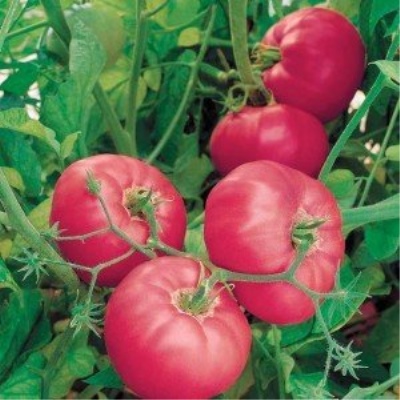
- Authors: Dederko V.N., Postnikova O.V.
- Year of approval: 2012
- Category: grade
- Growth type: indeterminate
- Appointment: universal
- Ripening period: mid-season
- Ripening time, days: 120
- Growing conditions: for open ground, for film greenhouses
- Marketability: high
- Bush size: tall
Many gardeners and farmers prefer to grow proven tomato varieties that give stable and high yields from year to year. Among the tested and loved by many are the mid-season Soviet tomato variety, which grows both in beds and in film greenhouses.
Breeding history
Varietal Soviet tomatoes were bred by domestic breeders (Dederko, Postnikova) in 2011. Recorded in the State Register of Breeding Achievements of the Russian Federation and allowed for use in 2012. The main task of the scientists was to create a large-fruited nightshade culture that grows in any climatic zone in greenhouses and open ground. The variety is zoned in all regions of Russia.
Description of the variety
The Soviet tomato is a tall plant of an indeterminate type, growing to a height of 200 cm. The bushes are characterized by moderate thickening with dark green leaves, a strong central stem, weak branching, a developed root and simple inflorescences. When growing a culture, it is recommended to form a bush of 1-2 stems, regularly remove unnecessary stepsons, pinch the top a month before the end of fruiting, and also tie up the trunk and branches, which can break off under the weight of large berries. In addition, after the formation of 7 inflorescences, the rest must be removed.
The variety belongs to universal, therefore it is widely used in cooking, processed, canned, frozen.
The main qualities of the fruit
The Soviet tomato attracts with its appearance. It belongs to large-fruited tomatoes. When fully ripe, the vegetable evenly stains a raspberry color, and in an unripe form it has a green color with a speck at the base. The giant tomato on average gains a weight of about 297 g, but in some cases the vegetable grows up to 400-600 grams. The tomato has a flat-round shape, with a noticeable ribbing of the surface. The skin of the vegetable is thin and shiny. Tomatoes tolerate transportation well, but their keeping quality is average. Only tomatoes that are gaining a huge mass (more than 500 grams) are prone to cracking.
Taste characteristics
The taste of tomatoes is an advantage that captivates many. The pulp of the fruit is fleshy, dense, rather juicy, granular. The taste is dominated by pronounced sweetness, complemented by an incredible dessert aroma. The tomato pulp contains 3.5% sugars and 17.5% vitamin C. When cut, the juice does not flow out, and there are no voids inside.
Ripening and fruiting
Vegetable culture Soviet belongs to mid-season varieties. From the mass germination of seedlings to the first ripe tomatoes on a bush, 4 months (120 days) pass. Ripening occurs amicably. The most productive period is considered to be the period from July to August. Ripe tomatoes, despite their weight, do not crumble from the branches.
Yield
The yield indicators for this species are excellent. Fulfilling all the rules of agricultural technology, 7.9 kg of ripe tomatoes can be harvested from 1 m2.
The timing of planting seedlings and planting in the ground
The vegetable is grown in seedlings. Sowing of seeds is carried out in the first decade of March (60-65 days before the transfer of plants to a new location). The seed is preliminarily sorted out and disinfected. Germination of shoots occurs on the 5-7th day. Temporarily covering the boxes with glass or plastic will help speed up the emergence of seedlings.Healthy growth requires a temperature balance of 23-25 degrees and adequate lighting (more than 12 hours / day) in the room. The pick is carried out at the stage of the appearance of several true leaves.
It is recommended to plant bushes under the film in mid-May, and in the garden in early June. Outdoor cultivation is permissible only in the southern regions.

Growing tomato seedlings is an extremely important process, because it largely depends on whether the gardener will be able to harvest at all. All aspects must be taken into account, from seedbed preparation to planting in the ground.
Landing scheme
Along with agrotechnical rules, it is important to observe the scheme and density of tomato planting, which are individual for each type of tomato. No more than 3 plants can be planted per 1 m2. This will allow the bushes to get enough light / sun and fresh air. The optimal layout for planting is 50x50 cm.

Growing and care
Tomatoes grow in fertile soil, which is breathable, fertilized and weed-free. According to farmers, loams with neutral acidity are considered the best. It is better to plant seedlings in an area where legumes and root crops used to grow.
In order for a crop to give a high yield, it must be looked after: watered with settled water, apply fertilizers, form and tie up a bush, remove stepsons, pinch the top, loosen the soil, ventilate, and also protect from diseases and pests.




A plant needs different micronutrients at each stage of growth. All fertilizers can be divided into two groups: mineral and organic. Folk remedies are often used: iodine, yeast, bird droppings, eggshells.
It is important to observe the rate and period of feeding. This also applies to folk remedies and organic fertilizers.
Disease and pest resistance
The variety has good immunity, so the plant has resistance to many tomato diseases (top rot, late blight, fusarium wilt).


Resistant to adverse weather conditions
Due to their high stress resistance, tomatoes do not react to sudden temperature fluctuations, short drought and heat. A draft negatively affects the development.

























































































